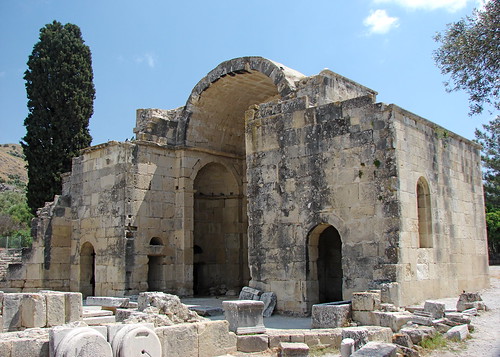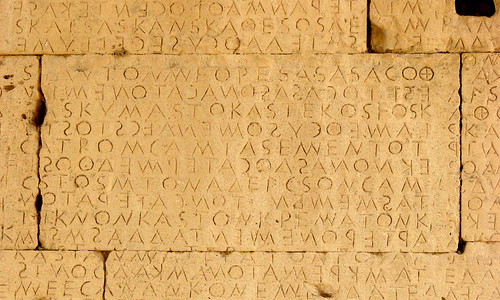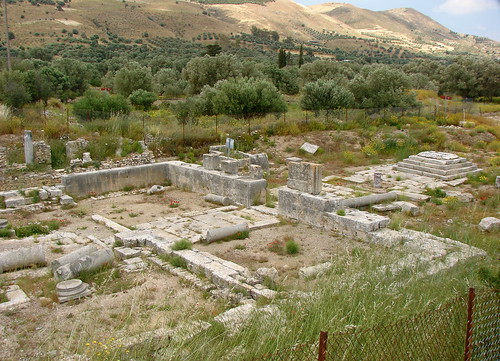Crete - Gortys
Since we had the car we thought we'd take a run over to Matala again but this time we'd stop off at the ruined city of Gortys, which is on the way there. Last time we were on Crete, we passed it by in our rush to get to the seaside and it was dark on the way back so we missed it.
Gortys, also known as Gortyn or Gortyna, was one of the most important cities on Crete. After the Roman conquest of Crete in 67 B.C., Gortys was declared the capital of the Roman province of Crete and Cyrenaica, replacing Knossos, a position it held until the Arab conquest of Crete in 828 A.D. It's probably most famous now for the discovery of the 12 inscriptions of law, which form the oldest Greek law code and are considered as the greatest contribution of Classical Crete to world culture.
The place lies in ruins now, mostly due to an earthquake in 796 A.D., but the site of this once huge city is massive. The main archaeological site, where you'll have to pay the usual entry fee, only covers a very small portion of the city - the Odeon, the Church of St. Titus and a Plane tree linked to the myth of Zeus and Europe. Frankly, there's not a lot on show here - the great inscription of the Law Code of Gortys and almost all of the recovered statues are all locked behind bars so you only get a glimpse of them. If you really want to experience the size of the place, then just wander around the outskirts or go across the road and dive in among the olive trees.
We wandered out and went along the road to the right. Once across the stream, there's a path leading back along the side of the main site but which also leads you along the side of the hill above. There are several ruins on the hillside and, if you're adventurous enough, access is open so you can wander in and up. The ground here is covered with flowers so I spent a few moments or three chasing butterflys among them as well.
We also crossed the road and wandered down the road opposite to Mitropolis for a bit and then plunged off left into the olive trees. The whole area in there is full of the ruins of the city. Some are obviously important as they've been fenced off but there's still lots to see and we spent a fair bit of time just wandering among the trees and flowers, enjoying the sun, before heading on to Matala.
Gortys, also known as Gortyn or Gortyna, was one of the most important cities on Crete. After the Roman conquest of Crete in 67 B.C., Gortys was declared the capital of the Roman province of Crete and Cyrenaica, replacing Knossos, a position it held until the Arab conquest of Crete in 828 A.D. It's probably most famous now for the discovery of the 12 inscriptions of law, which form the oldest Greek law code and are considered as the greatest contribution of Classical Crete to world culture.
The place lies in ruins now, mostly due to an earthquake in 796 A.D., but the site of this once huge city is massive. The main archaeological site, where you'll have to pay the usual entry fee, only covers a very small portion of the city - the Odeon, the Church of St. Titus and a Plane tree linked to the myth of Zeus and Europe. Frankly, there's not a lot on show here - the great inscription of the Law Code of Gortys and almost all of the recovered statues are all locked behind bars so you only get a glimpse of them. If you really want to experience the size of the place, then just wander around the outskirts or go across the road and dive in among the olive trees.
We wandered out and went along the road to the right. Once across the stream, there's a path leading back along the side of the main site but which also leads you along the side of the hill above. There are several ruins on the hillside and, if you're adventurous enough, access is open so you can wander in and up. The ground here is covered with flowers so I spent a few moments or three chasing butterflys among them as well.
We also crossed the road and wandered down the road opposite to Mitropolis for a bit and then plunged off left into the olive trees. The whole area in there is full of the ruins of the city. Some are obviously important as they've been fenced off but there's still lots to see and we spent a fair bit of time just wandering among the trees and flowers, enjoying the sun, before heading on to Matala.




No comments:
Post a Comment